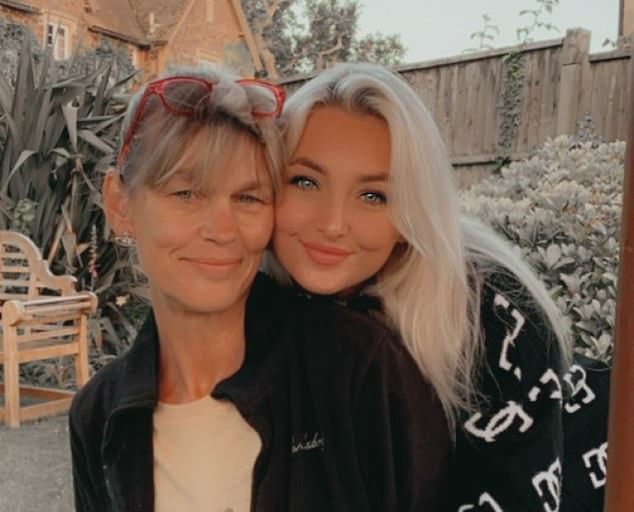As a teenager, Debbie Phillips’ daughter Paige always loved sunbathing. ‘When the sun came out, she was first into the back garden,’ Debbie recalls of her bubbly, charismatic girl. ‘She liked nothing better than getting brown.’
Blessed with startling blue eyes and a mane of blonde hair, Paige thought a tan enhanced her natural good looks.
It’s why, from her early 20s, she started regularly using sunbeds in order to get a year-round tan – so regularly that Debbie suggested she was overdoing it.
It made no difference. In fact, Paige also started to purchase ‘under-the-counter’ nasal tanners, a relatively new product designed to be sprayed up the nostrils to further darken the skin.
Earlier this year, Trading Standards issued a stark warning about the potential dangers of nasal tanners. Such products claim to work by delivering a substance known as Melanotan II, a synthetic chemical that stimulates the skin’s pigment cells to produce melanin, which darkens skin tone.
Yet early studies by the charity Melanoma Fund suggest it can cause nausea, vomiting, high blood pressure, kidney damage and even changes in mole shape and size.
However, while it is illegal to sell medicinal products containing the substance, many retailers promote them as cosmetic products – meaning they circumvent legal restrictions. And, sadly, these warnings came too late for Paige.
Within just a few months of using tanning sprays alongside sunbeds three times a week, she was diagnosed with a rare melanoma, an aggressive form of skin cancer, in her mouth.

From her early 20s, Paige started regularly using sunbeds in order to get a year-round tan – so regularly that Debbie suggested she was overdoing it
Over the next two years, and despite rounds of gruelling treatment and surgery, the cancer spread to her neck and lungs before progressing to her brain.
And just four months ago, this beautiful young girl with everything to live for died in a hospice bed at just 24, leaving behind a distraught family who are still coming to terms with the enormity of their loss. ‘Even now I can’t quite believe she’s gone,’ says Debbie, the devastation written on her face. ‘I miss her so desperately and would do anything to turn back the clock.’
The manner of her death is why she is speaking out today. ‘As a mum, I couldn’t stop Paige doing what she wanted. But having been through what we’ve been through, I want to do everything I can to spread the word about the dangers of obsessively pursuing a tan.
‘Once melanoma is in your bloodstream, you are already paying a price. Paige ultimately paid with her life – and we, her family, are left to live with our grief.’
Debbie’s warning could not be more timely. While many may assume the dangers of sunbeds have been made abundantly clear in recent years – legislation in 2010 made it illegal for sunbed businesses to allow under-18s to use their facilities – their use is now on the increase.
Startling new research by the charity Melanoma UK, in conjunction with fake tan brand Vita Liberata, shows that over the past decade the number of dedicated sunbed shops has doubled, fuelled in part by increased demand courtesy of social media hashtags promoting the perfect tan.
In tandem, there has been a 32 per cent increase in incidences of melanoma, leading them to launch a public health campaign to warn of the dangers of indoor UV tanning.
Meanwhile, dozens of social media influencers have been found to be advertising nasal tanners of the kind used by Paige. Some are marketed as ‘TikTok favourites’ and encourage people to use sunbeds four times a week, ‘gradually increasing minutes’ per session.
‘Research is still in its infancy, but it seems no coincidence to me that Paige developed black pigmentation all over the roof of her mouth within months of using these sprays,’ she says. ‘Paige also believed they were to blame – and I feel it is my duty to take her message to other young girls.’

‘I want to do everything I can to spread the word about the dangers of obsessively pursuing a tan,’ says Paige’s mum Debbie Phillips

Earlier this year, Trading Standards issued a stark warning about the potential dangers of nasal tanners – designed to further darken the skin
Today, Debbie, a 53-year-old activities co-ordinator for care homes, remains mired in grief, unable to return to work having taken leave to help look after her daughter in her final months. ‘Everything feels too raw,’ she says.
Her home in Warminster, Wiltshire, is dotted with pictures of her daughter and extended family, among them the young nephew that Paige will now not see grow up. ‘She loved children, and would have made a lovely mum herself,’ says Debbie.
Paige was the youngest of Debbie’s three children with her ex-partner; she had two older brothers, Sam, 28, and 25-year-old Vinnie. ‘I always wanted a girl, and Paige was my third time lucky,’ she smiles.
A confident, vivacious child, Paige was a natural performer and enrolled at the local dance school when she was just four, excelling in ballet, tap and jazz.
‘She joined an adult dance group when she was older and we danced together on stage a few times,’ says Debbie.
After leaving school, she went to work in hospitality, and the outward-facing nature of her job meant she always took care of her appearance. ‘She was always one for having her lashes done and other beauty treatments,’ says Debbie.
Then Paige started using sunbeds, influenced in part by friends who were doing the same.
‘She had lovely skin that always tanned well on holiday but, suddenly, that wasn’t enough,’ says Debbie. ‘I think there was an element of competition among the girls about who could be brownest and I’ve no doubt social media played a part too, as Paige was always following glamorous influencers.’
THE DANGERS OF USING NASAL SPRAYS
The rising popularity of nasal tanning sprays and injections has led to warnings from cancer charities and specialists about their dangers.
Both contain Melanotan II, an artificial substance which stimulates melanocyte cells in your skin to produce more of the natural pigment melanin, making the skin look darker.
David Carter, from the Medicines and Healthcare products Regulatory Agency, has warned that the Melanotan II products are unlicensed in the UK and the ‘side-effects could be extremely serious’. Charity Melanoma Fund UK says the key ones are nausea, vomiting and diarrhoea, with an increased risk of cardiovascular problems, kidney damage, brain swelling, sexual dysfunction and skin cancer.
Cancer Research UK also warns that Melanotan products are unregulated, meaning they haven’t been tested for safety, quality or effectiveness. Dr Pedram Gerami, professor of skin cancer research and director of Chicago’s Skin Cancer Institute and Melanoma Clinic, says: ‘If you overstimulate the melanocytes, there could be a theoretical association to melanoma.
‘As far as cancer is concerned, there have been sporadic cases of individuals reporting a combined onset of melanoma while using a nasal tanning spray.’
Another ingredient in the sprays is dihydroxyacetone, which can cause free radicals – unstable molecules, the production of which has also been linked to cancer – to form.
Advertisement
At first, Debbie did not pay too much attention to her daughter’s glowing tan; only when Paige’s then-boyfriend mentioned that Paige was ‘maxing it out’ at the salon did she start feeling concerned. ‘He told me that on occasion Paige would throw up when she came out,’ she says. ‘That’s when I said she needed to back off. I suspect she was using it for longer than the recommended 15 minutes.’
But Paige didn’t. ‘If anything, it became an obsession,’ says Debbie. ‘She wouldn’t listen.’
Then, on a mother-and-daughter holiday, Paige showed her a £47 nasal spray she had bought at the tanning salon she used. ‘She told me it came from under the counter and the man at the salon had recommended it because it enhances tanning,’ she says.
While sceptical, Debbie was unaware of the dangers. ‘More than anything, I thought it was a waste of money,’ she recalls.
In summer 2023, Paige pointed out a red blob in the gum above her two front teeth. ‘It looked like she had gone a bit mad brushing her teeth. I said she should go easy until it died down,’ she says.
But it didn’t die down: weeks later, Debbie noticed that the growth had got bigger.
‘You could see it when she smiled, and that’s when I told her she had to go to the dentist.’
Far from being a routine appointment, Paige was told the news that would turn her world upside down. ‘The dentist said, “I’m not touching you. This looks like melanoma.” She was devastated,’ says Debbie.
Paige was immediately referred to a hospital in Salisbury, where she received worse news: the roof of her mouth was also covered with black pigmentation. ‘The doctor hadn’t seen this before, and nor had others – quite a few came to look and take photographs.’
Initially, her consultant reassured her that she thought there was nothing to worry about. But two weeks later, Paige was given the horrifying news that it was, in fact, melanoma. ‘She rang me absolutely distraught,’ says Debbie today. ‘I think she had been hoping it was all a terrible mistake.’
From the outset, although she could never be completely sure, Paige was convinced the nasal tanning sprays were responsible.
‘She spoke to the doctor, who had not come across them before, but was very intrigued,’ says Debbie.
Paige was initially told that surgeons would need to remove her two front teeth and the entire roof of her mouth, which would be replaced with a special denture. ‘That was a huge thing for a young girl to face,’ says her mother.
In the event, while Paige’s two front teeth still needed to be removed, the consultant instead decided to skim off a layer of skin from the roof of her mouth, replacing it with a graft from her thigh.
‘This was still major surgery,’ says Debbie. ‘Paige was in hospital for several nights and needed a feeding tube. It was hard to go through and she was really upset.’
In addition, she had to undergo five immunotherapy sessions – in which drugs are administered intravenously, using the body’s immune system to find and attack cancer cells – which meant freezing her eggs because fertility can be affected by the treatment. While oral melanoma is rare, it is often very aggressive.
‘It was a lot to cope with as it had all happened so suddenly, but she was determined not to let it get her down,’ says Debbie. ‘Anyone who didn’t know would have had no idea what she was enduring.’
While receiving immunotherapy, Paige also had to undergo another operation as the pigmentation returned to the roof of her mouth. ‘It required a secondary operation taking off another margin where the pigmentation was,’ says Debbie.
By January 2024, frequent scans revealed a further blow: Paige had developed cancerous tumours in her neck which needed to be treated immediately with gruelling daily radiotherapy.

Paige developed black pigmentation all over the roof of her mouth within months of using these sprays, says Debbie, and was convinced the sprays were responsible

Debbie is backing the campaign by Melanoma UK and Vita Liberata to see health warning stickers on all sunbeds, and for a complete ban on nasal tanners
She was fitted with a feeding tube as she was unable to swallow, and over the course of the treatment developed bowel problems which at times were so severe that she had to be hospitalised.
‘She tried her best to remain cheerful, but she’d get low because she had to be near a bathroom and it meant she couldn’t live a normal life like her friends,’ says Debbie.
‘Whenever she could, though, she would go out with the girls. It would worry me, because my instinct was to wrap her up in cotton wool. But now . . .’ she pauses, choking back tears, ‘I thank God she did.’
As 2024 unfolded, Paige’s problems accumulated further: she developed a blood infection which spread to the heart and at one point was hospitalised for eight weeks as doctors contemplated whether to perform open-heart surgery.
‘That was terrifying for Paige,’ says Debbie.
Thankfully, drug treatment managed to resolve the issue and by September – when Paige turned 24 – it seemed like things were on the up.
Not for long, though. By the end of November, one of her regular scans showed cancerous cells were present in her lungs. She was referred to the Royal Marsden hospital in London for what she was told would be specialised treatment starting in the new year.
And by Christmas, Debbie started to notice a difference in her otherwise defiantly spirited daughter. ‘She said she felt fine, but it seemed like some of her spark had gone,’ says Debbie.
In January, another scan showed the cancer had migrated to Paige’s brain. ‘I looked at the doctor and asked if she was going to get through this,’ recalls Debbie. ‘And as she went to answer, Paige told her not to say anything. It was like she didn’t want to know, and I had to respect that. As a mum, I just had to stay strong with her.’
Nonetheless, she recalls breaking down the moment she was alone. ‘No mum wants to see her daughter suffer like this,’ she says, choking back tears. ‘I went to bed because all I wanted was for everything to go away.’
Paige was referred for gamma knife radiosurgery, which uses highly focused beams of radiation to treat brain tumours – yet on the day she turned up for her first set of treatment and another scan, she was told the hospital couldn’t proceed.
‘When we asked why, the doctor said the scan now showed Paige had about 70 tumours on the brain and it was too many to target,’ says Debbie. ‘For the first time, I really saw my daughter go into meltdown.
‘She had been so strong, so defiant, but she was now crying, saying she didn’t want to die. And I just couldn’t take it in, because she still looked so well.’
The only tiny ray of hope lay in whole brain radiotherapy, a procedure which treats the entire brain. Yet within a few days, even that possibility was dashed. ‘The consultant said they had to stop treatment because nothing was working and we were out of options,’ she says. ‘It didn’t feel real. I remember Paige’s nurse cuddling her and I just kept asking over and again what they meant.’
That quickly and tragically became all too evident: Paige’s condition deteriorated frighteningly fast. Routinely hospitalised in order for her lungs to be drained of fluid build-up, she also started experiencing terrifying seizures. ‘Her behaviour started to change because of what was going on in her brain,’ says Debbie. ‘One minute she could be fine, the next very aggressive.’
Even amid all this, Paige remained resolute, refusing to discuss the possibility of leaving her flat. But after two harrowing weeks of being cared for at home by nurses, family and friends, Paige was persuaded to travel to her local hospice.
Just 48 hours later, at 8.20pm on March 2, Paige died with her family at her bedside.
‘It happened so quickly at the end,’ says Debbie. ‘I keep thinking I’m in a very bad dream. We weren’t just mother and daughter. She was my best friend. We did everything together. And now all that is gone.’
It is for this reason that Debbie is backing the campaign by Melanoma UK and Vita Liberata to see health warning stickers on all sunbeds, and for a complete ban on nasal tanners.
‘A lot of young people have no idea of the dangers,’ she says. ‘I can’t bring Paige back, but if I can stop another family going through our agony then her death will not have been in vain.’








